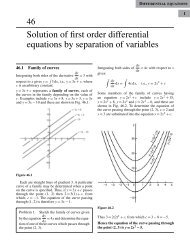differentiation
You also want an ePaper? Increase the reach of your titles
YUMPU automatically turns print PDFs into web optimized ePapers that Google loves.
306 DIFFERENTIAL CALCULUS<br />
1. y = 3x 2 − 4x + 2<br />
[<br />
Minimum at<br />
( 23<br />
, 2 3)]<br />
2. x = θ(6 − θ) [Maximum at (3, 9)]<br />
3. y = 4x 3 + 3x 2 − 60x − 12<br />
[ ]<br />
Minimum (2, −88);<br />
Maximum( − 2.5, 94.25)<br />
4. y = 5x − 2lnx<br />
[Minimum at (0.4000, 3.8326)]<br />
5. y = 2x − e x [Maximum at (0.6931, −0.6136)]<br />
6. y = t 3 − t2 2 − 2t + 4<br />
⎡<br />
Minimum at (1, 2.5);<br />
⎣<br />
Maximum at<br />
(<br />
− 2 3 ,422 27<br />
⎤<br />
)<br />
⎦<br />
7. x = 8t + 1<br />
2t 2 [Minimum at (0.5, 6)]<br />
8. Determine the maximum and minimum values<br />
on the graph y = 12 cos θ − 5 sin θ in the<br />
range θ = 0toθ = 360 ◦ . Sketch the graph<br />
over one cycle showing relevant points.<br />
[ Maximum of 13 at 337 ◦ 23 ′ ]<br />
,<br />
Minimum of −13 at 157 ◦ 23 ′<br />
9. Show that the curve y = 2 3 (t − 1)3 + 2t(t − 2)<br />
has a maximum value of 2 3<br />
and a minimum<br />
value of −2.<br />
28.4 Practical problems involving<br />
maximum and minimum values<br />
2x + 2y = 40,<br />
or x + y = 20 (1)<br />
Since the rectangle is to enclose the maximum possible<br />
area, a formula for area A must be obtained in<br />
terms of one variable only.<br />
Area A = xy. From equation (1), x = 20 − y<br />
Hence, area A = (20 − y)y = 20y − y 2<br />
dA<br />
dy<br />
= 20 − 2y = 0<br />
for a turning point, from which, y = 10 cm<br />
d 2 A<br />
dy 2 =−2,<br />
which is negative, giving a maximum point.<br />
When y = 10 cm, x = 10 cm, from equation (1).<br />
Hence the length and breadth of the rectangle<br />
are each 10 cm, i.e. a square gives the maximum<br />
possible area. When the perimeter of a rectangle<br />
is 40 cm, the maximum possible area is 10 × 10 =<br />
100 cm 2 .<br />
Problem 16. A rectangular sheet of metal having<br />
dimensions 20 cm by 12 cm has squares<br />
removed from each of the four corners and<br />
the sides bent upwards to form an open box.<br />
Determine the maximum possible volume of<br />
the box.<br />
The squares to be removed from each corner are<br />
shown in Fig. 28.8, having sides x cm. When the<br />
sides are bent upwards the dimensions of the box<br />
will be:<br />
There are many practical problems involving maximum<br />
and minimum values which occur in science<br />
and engineering. Usually, an equation has to be<br />
determined from given data, and rearranged where<br />
necessary, so that it contains only one variable. Some<br />
examples are demonstrated in Problems 15 to 20.<br />
Problem 15. A rectangular area is formed having<br />
a perimeter of 40 cm. Determine the length<br />
and breadth of the rectangle if it is to enclose the<br />
maximum possible area.<br />
Let the dimensions of the rectangle be x and y. Then<br />
the perimeter of the rectangle is (2x + 2y). Hence<br />
Figure 28.8<br />
length (20 − 2x) cm, breadth (12 − 2x) cm and<br />
height, x cm.<br />
Volume of box,<br />
V = (20 − 2x)(12 − 2x)(x)<br />
= 240x − 64x 2 + 4x 3










